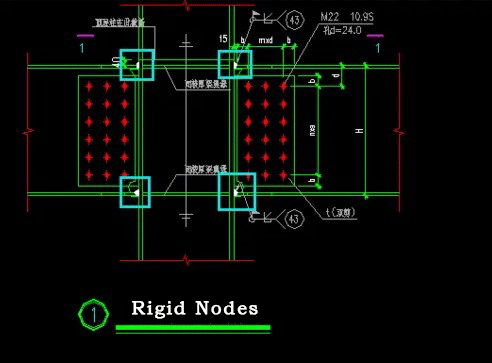Rigid and hinge nodes are two different types of connection nodes used in structural engineering, which differ significantly in terms of the degrees of freedom and deformations they impose on the connected members. The following are the main differences between rigid and hinged nodes:
|
|
|
|
|
Degree of freedom limitations: |
Rigid nodes limit the degrees of freedom of the connected members at that node, usually with minimal restrictions on deformation by displacement and rotation. The presence of a rigid node allows little deformation of the connection relative to the node. |
Hinged nodes allow relative displacements and rotations of the connected members at the node, with relatively small limitations on the degrees of freedom. The presence of hinge nodes allows the connection members to deform freely to some extent. |
|
Deformation capacity: |
the deformation capacity of the rigid nodes is minimal, the connection of the members in the vicinity of the node will not occur in almost relative displacement or rotation. |
hinged node members at the node can be relatively free of displacement and rotation, thus allowing a certain degree of deformation. |
|
Force transfer: |
Rigid nodes can effectively transfer bending moments and shear forces, the members of the connection at the node of the force are relatively rigid. |
Hinged nodes are often used to simulate nodes in specific situations, for example, under seismic action, hinged nodes allow members to form hinges at the nodes, which helps to reduce the seismic response of the structure. |
|
Application Scenarios: |
Rigid nodes are often used in structures where the rigidity of the nodes needs to be emphasized, e.g., in cases where the geometry needs to be kept constant. |
Hinged nodes are often used to simulate hinges that may occur in real structures, e.g., in a large earthquake, a building structure may form hinges at certain joints to minimize damage to the structure. |
|
Design considerations: |
Rigid nodes are designed for high rigidity to ensure minimal deformation at the joints, which helps to maintain the stability of the structure. |
Hinged nodes are usually designed to minimize damage to the structure by considering the need for hinged deformations under certain conditions, such as during strong earthquakes. |
Overall, rigid and hinged nodes are each suitable for different design scenarios, and their selection depends on the structural engineer’s specific requirements for structural performance and deformation.











 About Us
About Us 2024-01-17
2024-01-17




